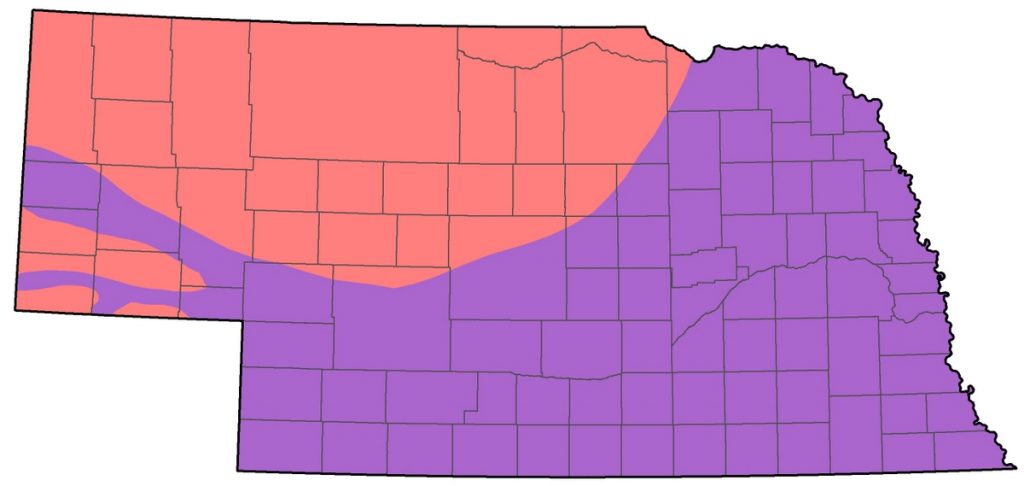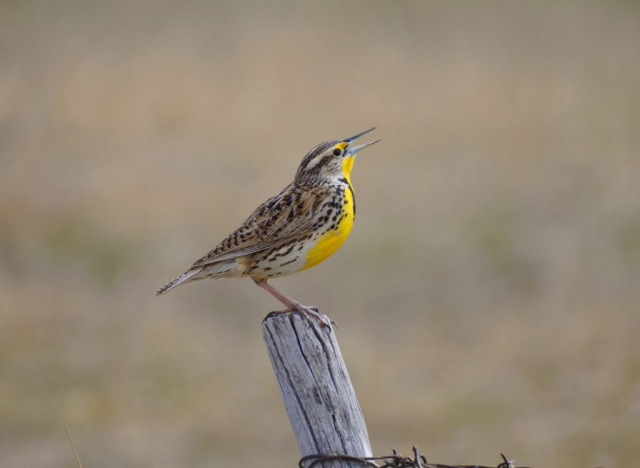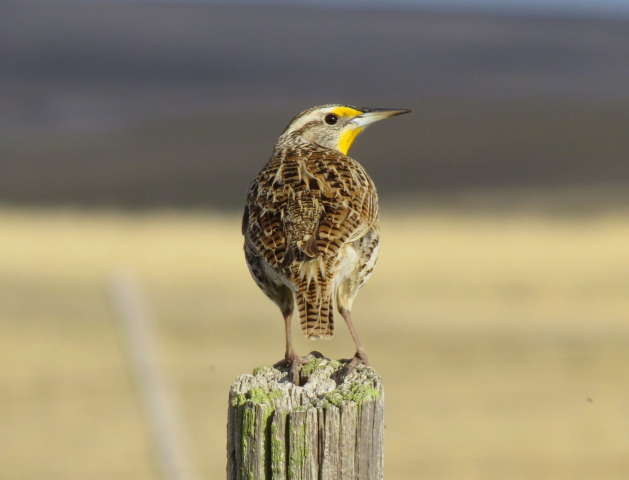Sturnella neglecta neglecta
Status: Abundant regular spring and fall migrant statewide. Abundant breeder west, central, and northeast, common southeast. Fairly common regular winter visitor south and east, uncommon elsewhere.

Documentation: Specimen: UNSM ZM11049, 30 Oct 1890 Lincoln, Lancaster Co.
Taxonomy: Two subspecies are recognized (AviList 2025): confluenta, breeding from coastal southwest British Columbia to southwest California, wintering to western Arizona, and neglecta, breeding from interior southern British Columbia to southeast California east to southern Ontario and northwest Louisiana, wintering to southwest California and Mississippi.
Nebraska birds are neglecta.
Hybridization with Eastern Meadowlark occurs but is thought to be extremely rare; see hybrid meadowlark account HERE.
Bruner et al (1904) suggested that Western Meadowlarks from “the lake region of Cherry County” differ in some respects from both Eastern Meadowlarks and Western Meadowlarks from elsewhere in Nebraska, although “the sending of specimens east has so far failed to satisfactorily settle their relationship”. We were unable to find details on these differences; we are unaware of any DNA studies that have included samples from the Nebraska Sandhills population.
Spring: Migration timing is difficult to determine because of the presence of wintering birds, but arrival of migrants is characterized by small flocks of 15-40 birds (“choirs”; Lanny Randolph, Robin Harding, personal communication) which begin singing as early as late Jan. There was “multiple singing” in northern Antelope Co 12 Jan 2014, and 31 were singing near Darr, Dawson Co 9 Feb 2003. Far-flung singles were calling as far north as Knox Co 14 Feb 1999 and as far west as Scotts Bluff Co 15 Feb 2002, as well as a group of 15 on 4 Feb 2006 that may have been early migrants or wintering birds.
- High counts: 551 in Pierce Co 8 May 1999, 300 along Elm Island Rd, Buffalo Co 13 Mar 2017, and 250 at Prairie Dog WPA, Kearney Co 28 Mar 2023.
Summer: Western Meadowlark breeds commonly statewide in all types of grasslands and most agricultural landscapes; as many as 2000 were at Crescent Lake NWR, Garden Co 30 Aug 1998. It now occurs at low densities in intensely agricultural regions of the east and also in the extreme southeast, where Eastern Meadowlark also breeds. The two species usually segregate into habitats according to moisture, with Western Meadowlark occupying drier habitat than Eastern Meadowlark, although there are areas where the two occur together (Lanyon 1957). Mollhoff (2016) showed statewide distribution, with somewhat fewer reports in the extreme southeast.
- Breeding phenology:
- Nest building: 20 May
Eggs: 5 Apr-14 Aug (Mollhoff 2022)
Nestlings: 26 May-24 Jun
Fledglings: 17 Jun-19 Sep
- High counts: 115 in 3 miles Ogallala NG, Sioux Co 22 Jun 2024, and 110 in 4.45 miles along Road 179 north of Oshkosh, Garden Co 2 Jun 2024.
Fall: Flocking begins as early as Jul; a group of 20 was in Cuming Co 15 Jul 2019.
Main fall movement begins in Oct, and much of the western Sandhills is vacated by Nov; in Dec only wintering birds remain, mostly limited to the south and east (eBird.org, accessed Jan 2024).
Departure from the state varies from year to year. This is illustrated by a banding recovery in Arkansas 30 Nov 1940 of an individual banded in Lincoln Co, Nebraska 21 Jan 1940. This bird apparently wintered in Nebraska 1939-40, but had already left Nebraska and arrived in Arkansas, some 500 miles to the southeast, by Nov of the subsequent winter.
- High counts: 465 in Garfield Co 2 Oct 2016, 300 at Gibbon, Buffalo Co 25 Oct 1998, and 300 in Garfield Co 12 Oct 2003.
Winter: Western Meadowlark winters over most of the state, although numbers vary considerably from year to year (see Fall) and it may be absent from large parts of the state in some years. CBC data indicate that by late Dec, Western Meadowlarks are still fairly evenly distributed over most of the state; birds per party-hour varies from 1-3 in the north to 101+ in the extreme south (Root 1988).
Highest single location CBC count was 655 at Kearney, Buffalo Co 15 Dec 2024. The 578 at Lincoln in 1972 was another good count, also the year for the highest total number of Western Meadowlarks on all counts, 1401. This contrasts with the low of only 58 in 1984.
- High counts: (non-CBC; late Dec-early Feb): 205 in Nuckolls Co 24 Jan 2025, 155 in Nuckolls Co 18 Jan 2020, and 100+ in Washington Co 24 Jan 2007.
Images
Abbreviations
CBC: Christmas Bird Count
NG: National Grasslands
NWR: National Wildlife Refuge
UNSM: University of Nebraska State Museum
WPA: Waterfowl Production Area (Federal)
Literature Cited
AviList Core Team, 2025. AviList: The Global Avian Checklist, v2025. https://doi.org/10.2173/avilist.v2025.
Bruner, L., R.H. Wolcott, and M.H. Swenk. 1904. A preliminary review of the birds of Nebraska, with synopses. Klopp and Bartlett, Omaha, Nebraska, USA.
Lanyon, W.E. 1957. The comparative biology of the meadowlarks (Sturnella) in Wisconsin. Cambridge, MA: Publ. Nuttall Ornithological Club, No. 1.
Mollhoff, W.J. 2016. The Second Nebraska Breeding Bird Atlas. Bull. Univ. Nebraska State Museum Vol 29. University of Nebraska State Museum, Lincoln, Nebraska, USA.
Mollhoff, W.J. 2022. Nest records of Nebraska birds. Nebraska Ornithologists’ Union Occasional Paper Number 9.
Root, T. 1988. Atlas of wintering North American birds, an analysis of Christmas Bird Count data. Chicago: University of Chicago Press, Chicago, Illinois, USA.
Recommended Citation
Silcock, W.R., and J.G. Jorgensen. 2025. Western Meadowlark (Sturnella neglecta). In Birds of Nebraska — Online. www.BirdsofNebraska.org
Birds of Nebraska – Online
Updated 23 Jul 2025


